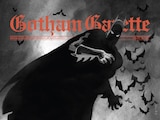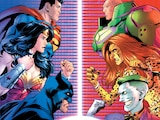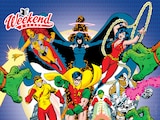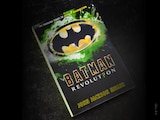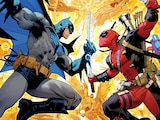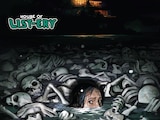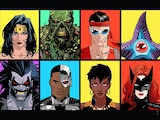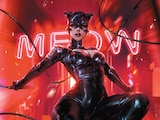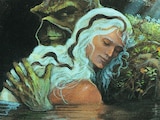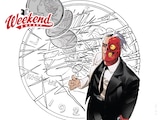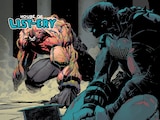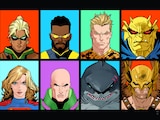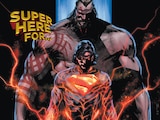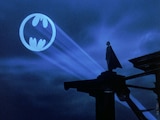Welcome back to ASK…THE QUESTION, the all-time greatest regular feature on DC.com. That’s right, “House of List-ery” (a phrase I coined, by the way), I’m calling you out. I’m Alex Jaffe, better known to our active, boisterous Discord community of 27,500 DC fans and seekers of truth as HubCityQuestion. In this column, I highlight some of the most compelling, illuminating questions I’ve received as the self-appointed keeper of all DC knowledge. My secret? If there’s something I don’t know, I go out and find it for you. It’s that pursuit of knowledge that keeps me strong. After all, you can’t spell “Question” without a “Quest.” Let’s serve up some mystery.

DrWhoDidle asks:
Hello! Just finished Batman: Hush and I was surprised that Hush didn’t steal anyone’s face because I thought that was his whole gimmick. Was this an invention of Batman: Arkham City, or did this trait appear before the game?
Hush’s penchant for extreme self-makeovers isn’t exclusive to Arkham City, but it did come to us courtesy of Arkham City’s head writer, Paul Dini. Long before this year’s H2SH, Dini gave us a different sort of sequel in the 2008 Detective Comics storyline “Heart of Hush.” It’s here that Hush takes his surgical techniques, used so deftly on the likes of Bruce Wayne, Harvey Dent and Harold in the original Hush storyline, and applies them to himself, forging his likeness into an exact match for Bruce Wayne. This particularly comes in handy for him following Batman’s apparent death in Final Crisis, after which our Dr. Thomas Elliot uses his doctored visage for a temporary takeover of Wayne Enterprises—a farce which Batman’s allies allow him to pursue under their direct supervision as the real Batman struggled through time to return home. With all the work Dini put into that aspect of the character, it’s easy to understand how he’d return to it for his involvement in the first two Arkham games.

DragonMoth asks:
I just finished Dan DiDio and Keith Giffen's short-lived O.M.A.C., and I remember Kevin Kho showed up in the New 52's Justice League International and later briefly in Blue Beetle (2016). Has he appeared elsewhere since?
Dan DiDio had big plans for the Kevin Kho iteration of O.M.A.C. at the start of the New 52, which the late Keith Giffen was more than happy to oblige in his later work during that era. But outside of some deep background cameo appearances, there’s only been one significant appearance for Kevin since he featured in the Rebirth run of Blue Beetle—issues #4 and #5 of DiDio’s own Metal Men series, the former publisher’s swan song and tribute to his longtime favorite group of heroes. DiDio’s final Kevin Kho story concluded with his connection to the Brother Eye satellite getting fried beyond repair, apparently ending his career as O.M.A.C. forever… That is, until someone chooses to continue his story.
sparkling gold unicorn asks:
When was the first hero published?
This really depends on what your definition of "hero" is. Recorded hero fiction dates back to at least 1200 BC, with the Epic of Gilgamesh.
The first comics "superhero" was a character called "Hugo Hercules," a short-lived 1902 newspaper strip by Wilhelm Heinrich Detlev Körner in the Chicago Tribune. The costumed hero archetype would catch on the next year, with 1903's “The Scarlet Pimpernel”—in a play written by Baroness Emmuska Orczy.
The 1910s, 1920s, and early 1930s would give us a variety of early characters you might call "superheroes," like John Carter, Tarzan, Zorro, Buck Rogers, Popeye, the Shadow, the Lone Ranger and Tonto, Green Hornet, Conan the Barbarian, Doc Savage, Dick Tracy, Flash Gordon, Mandrake the Magician, the Phantom and Hugo Danner.
The first costumed, codenamed hero character specifically from DC Comics would be Doctor Occult, who debuted in 1935's New Fun #6—the sixth comic book DC ever published. He was created by Jerry Siegel and Joe Shuster, who, three years later, would go on to publish Superman.

Mithrophon asks:
I was rereading DC Comics Presents #55, a comic from my youth written by none other than the Answer Man himself, Bob Rozakis! In this comic, Superman "time tunnels" to the past to see the original Air Wave prevent Superboy from being exposed to gold kryptonite, thus saving his career. While in the past, though, Superman says that he's only a phantom since he already exists in this time period (so he can observe but not interact). Has this rule of time travel been kept up in comics since then? Was Rozakis citing a time-travel convention that had been used many times before, or did he invent it for this story? And can Superman "time tunnel" in comics today, picking a certain date/year and going back to observe it?
The most honorable Answer Man didn’t make this one up. Like much of his work, it was built on years and years of comic book storytelling tradition. In this case, Superman’s ability to travel back in time as an intangible “time phantom” dates back to 1948’s Superman #53, the very first time Superman gets to witness the destruction of Krypton with his own eyes. Superman’s ability to travel backward through time at will was lost along with many of his more obscure abilities with John Byrne’s Superman relaunch following Crisis on Infinite Earths.
Seraph asks:
Mr. Mxyzptlk is banished by speaking his name backwards, and the Zatara family's magic is achieved by speaking the incantation backwards. Is there a relationship between the magic used by the Zatara family and the fifth dimension?
I’ve often seen speculation along these lines, but no connection between the imps and the Zatara clan has been drawn. The purpose of backwards speech in both cases is quite different. In Mxyzptlk’s case, the rules where he gets banished to his own dimension when he says his name backwards are enforced by Mxyzptlk himself. Seeing his quarter-annual sparring sessions with Superman as a game, Mxyzptlk invented a loss condition so that Superman could have a fair chance of defeating him.
The Zatara family’s backwards speech serves an entirely different purpose. In the DC Universe, magic is all about intention. Backwards speech is used by the Zatara family as a focusing tool, forcing the spellcaster to mentally focus on what they wish to manifest by defamiliarizing themselves with straightforward, rote language.

Jurisdiction asks:
When was the first time Batman used the "Matches Malone" identity?
That addition to Batman’s repertoire comes to us courtesy of the legendary Dennis O’Neil, in 1972’s Batman #242. Batman takes up the criminal identity shortly after we witness the real Matches Malone take a fatal bullet, helping to maintain a complicated fiction involving the faking of Bruce Wayne’s death. The Matches identity has been a useful tool to explore the Gotham underworld from the inside ever since.
Cornholio asks:
I was wondering what were the first and last DC comics to have a letters page? And is there a reason they stopped showing up?
The first DC book with a letters page was Real Fact Comics #3, in 1946. After nearly 60 years of functioning as DC’s primary medium for connecting with fans, the company retired the feature across all their titles at the end of 2002. By that time, comic discourse had moved away from print, now mostly taking place online, and the letter column as a means of open communication had become redundant. There was a brief, nostalgia-motivated resurgence of the feature in 2011, but that also ended with the advent of the New 52 initiative.
The heir to the DC letter column today? You’re reading it, baby!

Redemption asks:
What caused Bane to want to fight Batman?
Bane’s motivation in breaking the bat is glossed over rather quickly in the original Knightfall event. Dennis O’Neil’s novelization of Knightfall makes it a little clearer: while he was imprisoned in Peña Duro, his fellow inmates and eventual henchmen Trogg, Bird and Zombie, each formerly from Gotham, built up the legend of Batman as the supreme warrior in an environment of true fear—a role Bane felt akin to as the undisputed reigning power within the Pit. Upon his escape, Bane was drawn to Gotham to challenge this mythical figure to prove his own supremacy and as a way of making a name for himself in the larger world. You’ve heard of him, so I’d say he succeeded.
Years later, in 2021’s The Joker series, we would learn another account of what happened: a suggestion that Bane had specifically been bred and conditioned to seek out and defeat Batman, as part of an experimental program to develop the ultimate soldier. This is factual at least in the case of Bane’s biological clone, Vengeance. How great a factor it may have been in her father’s own origin is left open for speculation.
John Not Real Name asks:
How does Gotham City’s government function?
Poorly.

Manolisg asks:
Is there a reason why Kryptonians have a similar appearance to humans when most aliens in DC are more exotic?
Some more recent Superman adaptations, like TV’s Smallville and the 2013 film Man of Steel, have implied that ancient Kryptonians colonized Earth in the distant past and we may share common interstellar ancestry. But historically, there hasn’t been much explanation for those similarities in the comics. This can ultimately be chalked up to the standards of the evolving milieu of science fiction in the early to mid-twentieth century. The further back you go, even well into the 1950s and 1960s, the more alien species you’ll see—not just in DC comics, but throughout science fiction—that look nearly or completely identical to humans. Thanagarians and Rannians look as human as Kryptonians do, for example, as do many of the alien races featured on Star Trek or early Doctor Who. You can think of it simply a holdover from standards of the genre at the time.
That’s all the time we have for this month. But until our next column, I’m around for truly unhealthy hours on the DC Official Discord server to answer anything you need to know about the mysteries of the DC Universe in our #ask-the-question channel. I’ll be around to answer just so long as you ASK…THE QUESTION.
Alex Jaffe is the author of our monthly "Ask the Question" column and writes about TV, movies, comics and superhero history for DC.com. Follow him on Bluesky at @AlexJaffe and find him in the DC Official Discord server as HubCityQuestion.
NOTE: The views and opinions expressed in this feature are solely those of Alex Jaffe and do not necessarily reflect those of DC or Warner Bros. Discovery, nor should they be read as confirmation or denial of future DC plans.

